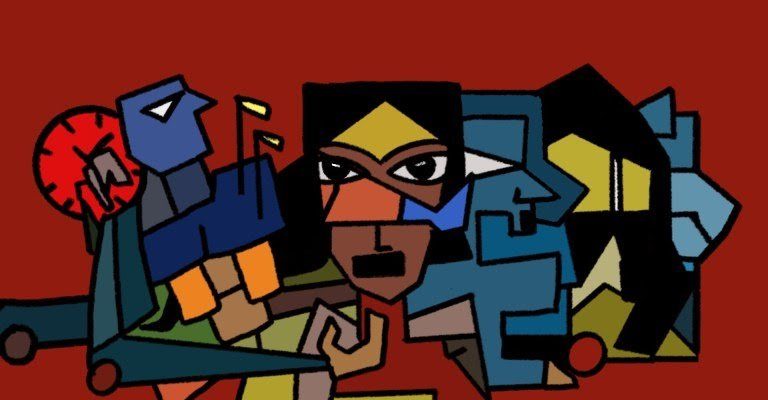In early April, Rekha Sharma, chairperson of the National Commission for Women, drew attention to the disturbing phenomenon of a reported increase in violence against women during the first phase of the nationwide lockdown in India. Even as the period of lockdown in India came to be extended, increase in domestic violence continued to be reported from India and across the world.
National dailies in India, apart from the New York Times, the Guardian and others have tracked some of these developments, reporting on the spurt in incidents and women’s frantic calls to helplines. News reports have pointed to the added stress of being locked in with abusers, and being cut off from support groups while being confined at home in times of social distancing.
The issue flagged merits serious attention from all concerned, be it the media or activists and, more so, from agencies of the state, charged with formulating and implementing policies to stem the tide of this violence. There is also a need to identify women and child abuse helplines and related support services as essential services in the wake of disasters. Those in charge of maintaining support services to women and children also need support and should be recognised as essential services within disaster management protocols and SOPs. This should form part of the understanding of teams set up to deal with the present crisis as also for the future.
Violence at home
The statement of the NCW chairperson focused on one of the crucial sites of violence against women – the home – which is the primary site of intimate partner violence. As in other parts of the world, more than four decades of focused research, activism and interrogation of the subject by the contemporary women’s movement in India and by social scientists has generated a wide spectrum lens to examine gendered violence. There are studies galore.
Substantial amount of data has been generated by official agencies – notably the NCRB, as also the NFHS, to promote an informed discussion on the phenomenon, not to speak of NGO reports. For recent years, information has been gathered through the MHRD’ s dashboard to coordinate with organisations providing assistance to affected women through the One Stop Centres, apart from the National and State level Women’s Commissions.
These together point to the pervasiveness of domestic violence in the country, cutting across regions, religions, social class, educational backgrounds and age of both victims and perpetrators. Studies and experience on the ground both puncture any understanding which may repeat stereotypes that only poor, uneducated men beat their wives and are abusive. There is a need to accept that in India certainly growing up male is about internalising a sense of the power of gender. Far from critical engagement with these prejudices, the gendering of power seems to have become a public project in recent years.
Also read: Is #BoisLockerRoom the Crime or the Symptom?
There is, in fact, a vast amount of literature available with regard to the continued ideological and social conditioning in our society, which sanctions patriarchal norms of subordination and subjugation. These assumptions are often, then, replicated in the law and in public policy. Public campaigns and women’s organisations’ experience of handling domestic violence cases on a day-to-day basis, for over four decades now, could well provide readings and learnings in handling social crisis at multiple levels, all at once. For the family, after all, is a microcosm of society. Nevertheless, while there is sufficient information in the public domain to push for wider public discussion on the subject, there is the need for more and better data, in order to concretely address issues of violence against women.
Nevertheless, even as we demand immediate and urgent redressal of complaints of domestic violence by individual women, should the battle for women’s individual rights and freedoms disallow scrutiny of more public forms of violence? Should a discussion on violence not encompass socio-cultural approaches and practices which prepare the ground for social acceptance of violence against women, apart from efforts to directly offer justification for the same? Clearly, the form, nature and extent of spread of violence against women in our society are on a scale that it may be difficult to find amongst us women who are not survivors. Hence also the need to develop a multi- layered approach.
Looking beyond domestic violence
There is a need to recognise that domestic violence is only one of the many forms of violence women are subjected to. Studies on violence against women in India, and elsewhere, have highlighted the need to develop a life cycle based understanding of the subject to deal with the incidence of violence women face. While the Nirbhaya incident remains etched in public memory, the fact remains that the incidence and spread of everyday violence against women in both urban and rural India still largely goes unaddressed.
The horror unfolding with regard to the Bois Locker Room offers a more recent example, of what lies hidden beneath the surface. While it lays bare some of the hazards that young women face on a daily basis, it remains the proverbial tip of the iceberg. In fact, while a marketised economy opened up new sites of social conflict, with women representing an identifiably vulnerable social group, digital technologies now allow for previously unknown forms of exploiting women, through misogynist sexual fantasies.
Also read: The Rooftops Will Stay Free
The point is that such incidents, as also the threat of such violence, are everyday experiences for young women today and, can hardly be seen as an aberration. These drive home the urgent need to have more open conversations around gender, sexuality and norms of social interaction in private and public spaces. While some conversations around these issues started to take place after the Nirbhaya incident, there was a proverbial clamming up after that as was witnessed in responses to the MeToo campaign. Rather than push for open –minded debates on the subject, the route taken was of charges and counter charges, with sharp divides along gender lines in work places.
While a few have opted for the legal route, the process remains tardy, and understandably so, given the cloud of suspicion over the former chief justice and the Supreme Court’s opting for non-transparency in the matter. Undoubtedly, the scenes of corporate crimes where too violence against women is incessantly perpetrated remain largely hidden from the public eye. Not so the violations by agencies of state. Not the least when incessant campaigns are mounted to fix the public gaze on casting social philosophy in a singular mode, where again false binaries form the basis for debates on the future of the nation and the republic, on a daily basis. As the Verma Committee highlighted in its report in 2013, including in its summation of the Bill of Rights, violation of the human rights of women does and should not qualify for impunity for acts as national duty.
In this context, the continued pitching of media debates around violence against women as hinging on misogyny and patriarchies versus all else emerges as a matter of concern. Amongst scholars and activists, the stereotyping of genders ceased to be the peg for advancing nuanced debates much too long ago. As is often the case with issues concerning women, there is a risk in pushing aside the need for deeper analysis and drawing linkages between the context and roots of violence in tandem with wider social analysis, more so as media attention shifts to newer, more news worthy stories.
Signs of a social crisis
Violence against women today needs to be comprehended and countered within a more comprehensive frame. At one level, it is can be seen to be a critical manifestation of social crisis and conflict. These have roots in structures which uphold inequalities, social hierarchies and policies of discrimination and exclusion. These, unquestionably, also point to the violence inherent in development processes, which exacerbate existing differences and entrenched hierarchies, to allow for an axis of power along which violence against women continues to be inflicted with impunity.
Hence also the urgency to develop tools which adopt inter-sectional approaches to identify the structural roots of violence. It is also recognised that a period of crisis portends unleashing of violence on an unprecedented scale. Women in India and across the world have realised over long years, that the buck always stops with them. Undoubtedly, inside the home, failures and frustrations are written in brutal forms over the bodies of women.
The recent round of discussion on the opening up of alcohol shops offers a case in point. Amongst those dealing with incidents of violence, it is well-known that there is a definite link between drinking and violence against. This is true for both, drinking and wife-beating and for binge-drinking which often lies behind the growing incidence of randomly inflicted violence against women in the public domain.
In popular perception, urban modernity in India seems to be defined by a heady cocktail of ‘wining, dining and women,’ with unacceptable levels of tolerance to unacceptable social behaviour under the pretext of a person being under the influence of alcohol. Despite these facts being on record, confining the public discourse on drinking, or for that matter, alcoholism and addiction, to its links with domestic violence may not be the most appropriate strategy. Just as prohibition in a particular state may not accord safety or dignity to women. In fact there is a need for more empirical studies on these aspects, drawing on state-level experiences of prohibition. Does prohibition or non-availability of liquor stem the tide of violence? Perhaps the latest experience of lockdown may allow for more critical reflection.
Confused government action
What can be more bizarre than the recent round of debate on alcohol policy that was witnessed during lockdown? To pit women’s safety against the need to generate revenues for the state to deal with the virus in corona times is the worst form of economic analysis that can be offered, especially when the response of the state to the crisis throws up more questions than it answers. As for the matter of earnings from excise duties which the states depend on, should more serious analysis with regard to funds and allocation of resources to deal with the coronavirus crisis be allowed to be evaded in the name of alcohol versus violence against women?
A more robust debate on allocations and entitlements from federal funds is still to see the light of day. The test of governance, finally, lies in gauging the response of the state vis a vis its citizens. Especially towards those individuals and sections it chooses to see as less equal citizens. While there are many claimants for that tag in contemporary India, the large majority of women certainly count for a significant proportion amongst all the sub sets. There is, indeed, the need for greater political will to adopt and implement a policy of zero tolerance to violence against women, with or without alcohol.
Also read: In Tamil Nadu, Liquor Sales Are Churning a Blood Economy
Above all, we need to acknowledge that the coronavirus crisis compels us to think afresh and more seriously on notions of violence, rights and human dignity.
For several weeks now the country has witnessed the spilling out of entire families on the roads, criss-crossing highways and dusty roads to evade ‘borders’ in order to reach their homes. Are we to believe that these journeys were undertaken or completed without myriad forms of violence being perpetrated on and against those trudging long distances to reach their homes? The long march back, for crores of migrant workers, was a march to ‘homes’ that would need to be stitched and strung together from the debris of failed crops, unpaid loans, unfulfilled promises of love, life and caring, to near and dear ones across rural India.
Behind the statistics of relief packages pronounced and indifferently delivered on the ground, lies hidden the untold story of how besieged women feel in their everyday negotiation of gender rights in the midst of such an acute and persistent struggle for human dignity. They know that food, shelter and livelihood are the basics for them to assert their right to live a life of dignity. So long as the mass of women, and men, in India continue to be denied these, the vision of a violence-free society for women shall remain more than a distant dream. It is only too well-known that when the marginalised are subjected to violence – be they tribals, Dalits, minorities, landless, poor – the women of these communities suffer in specifically gendered ways.
The women’s movement recognised long ago that poverty and inequality in India create new danger zones and increase the vulnerability of women to violence. Social inequalities provide a breeding ground for perpetrators to carve out new paths to inflicting violence against women. The visuals to which urban India was exposed, sitting in the comfort of their homes during Lockdown offered just a few glimpses of the underbelly of our developmental path. Women have long known of its tortuous routes.
In the midst of countless tales of human suffering, the story of the death in Bijapur of Jamalo Madkam – a 12-year-old girl returning from working as a child migrant on a chilli farm just a few kilometres from her home – could not hold media attention beyond the moment. Similarly disturbing were the countless reports of women delivering babies on the road, and walking on, with no medical help. These shall remain etched in public memory as a telling tale of the failure of the state and society to shield children and women from the manifold vulnerabilities and violence that they are subjected to in their daily struggle to stay alive in present times.
Also read: Out of Work, Her Future in Doubt, a Woman Finds Refuge in TikTok
What this phase of work from home tells us is that a different, more inclusive understanding, which recognises diverse forms of the ‘domestic,’ of the ‘home’ and of violence against women are required today. Policy and governance need to be more sensitive towards the need to build ‘homes’ and envisage policies to prevent violence against women.
Upholding and implementing rights and guarantees given to women as per the Indian constitution and existing laws by those in power would allow for and enable women to assert conscious citizenship. An end to everyday forms of publicly inflicted social violence is perhaps the first step towards enabling women to confront domestic violence in the private space. This may help the individual woman to negotiate her own life on a materially stronger plank to contribute towards nurturing such spaces as havens of love, peace and quietude.
In this context, an oft-repeated maxim that the condition of women is an indicator of social progress perhaps needs to be reformulated as follows: violence against women is an indicator of the depth of societal conflict and crisis in present times.
Indu Agnihotri was the director of the Centre for Women’s Development Studies, New Delhi.




